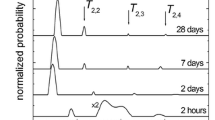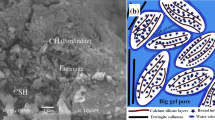Abstract
In the present study, we investigate the relationship between the nuclear magnetic resonance relaxation rate and the hydration time in two types of masonry cement-lime mortar. The studies are performed with the mortars both in an enclosed and a standard atmosphere to monitor the air influence on cement-lime mortar hydration and setting. The constituents of the investigated mortar samples are: cement, slaked lime, sand and water. They were mixed to achieve a flow spread of 10 cm. These types of mortars are usually suitable for historical masonry maintenance, but they can also be used for modern buildings, or even for concrete structures coatings to prevent concrete carbonation. All nuclear magnetic resonance relaxation experiments were performed at 20 °C using a low-field nuclear magnetic resonance instrument operable at 20 MHz proton resonance frequency. A slowing down of the hydration kinetics is demonstrated for the samples kept in closed atmosphere conditions. The results contribute to the understanding of cement–lime mortar hydration, carbonation and setting under closed atmosphere conditions.





Similar content being viewed by others
References
A.M. Neville, Properties of Concrete (Pearson Education Limited, Essex, 2004)
H.J.P. Brocken, N.M. Van der Pers, J.A. Larbi, Mater. Struct. 33, 634 (2000)
J.J. Brooks, B.H. Abu Bakar, Mater. Struct. 37, 177 (2004)
C. Ince, M. Carter, M. Wilson, N. Collier, A. El-Turki, R. Ball, G. Allen, Mater. Struct. 44, 509 (2011)
J.P. Korb, P.J. McDonald, L. Monteilhet, A.G. Kalinichev, R.J. Kirkpatrick, Cem. Conc. Res. 37, 348 (2007)
P.J. McDonald, V. Rodin, A. Valori, Cem. Conc. Res. 40, 1656 (2010)
K. Hazrati, L. Pel, J. Marchand, K. Kopinga, M. Pigeon, Mater. Struct. 35, 614 (2002)
I. Ardelean, R. Kimmich, Annu. Rep. Nucl. Magn. Reson. Spectrosc. 49, 43 (2003)
R. Kimmich, E. Anoardo, Prog. Nucl. Magn. Reson. Spectrosc. 44, 257 (2004)
F. D’Orazio, S. Bhattacharja, W.P. Halperin, K. Eguchi, T. Mizusaki, Phys. Rev. B. 42, 9810 (1990)
N. Nestle, P. Galvosas, O. Geier, C. Zimmermann, M. Dakkouri, J. Kärger, J. Appl. Phys. 89, 8061 (2001)
J.P. Korb, Curr. Opin. Coll. Int. Sci. 14, 192 (2009)
A. Valori, V. Rodin, P.J. McDonald, Cem. Conc. Res. 40, 1375 (2010)
R.M.E. Valckenborg, L. Pel, K. Hazrati, K. Kopinga, J. Marchand, Mater. Struct. 34, 599 (2001)
L. Pel, K. Hazrati, K. Kopinga, J. Marchand, Magn. Reson. Imag. 16, 525 (1998)
J. Ashurst, N. Ashurst, Practical Building Conservation: Mortars, Plasters and Renders, English Heritage Technical Handbook (Gower Technical Press, Aldershot, 1988)
S. Meiboom, D. Gill, Rev. Sci. Instrum. 29, 688 (1958)
S.W. Provencher, Comp. Phys. Comm. 27, 229 (1982)
K. Van Balen, Cem. Conc. Res. 35, 647 (2005)
K. Van Balen, D. Van Gemert, Mater. Struct. 27, 393 (1994)
B. Blümich, J. Perlo, F. Casanova, Prog. Nucl. Magn. Reson. Spectrosc. 52, 197 (2008)
Acknowledgments
This work was supported by a grant of the Romanian National Authority for Scientific Research, CNCS–UEFISCDI, project number PN-II-ID-PCE-2011-3-0238. Financial support by the European Social Fund (project POSDRU/88/1.5/S/60078) is also gratefully acknowledged.
Author information
Authors and Affiliations
Corresponding author
Rights and permissions
About this article
Cite this article
Simina, M., Molnar, L., Manea, D. et al. Monitoring the Air Influence on Cement–Lime Mortar Hydration Using Low-Field Nuclear Magnetic Resonance Relaxometry. Appl Magn Reson 43, 443–450 (2012). https://doi.org/10.1007/s00723-012-0389-7
Received:
Published:
Issue Date:
DOI: https://doi.org/10.1007/s00723-012-0389-7




